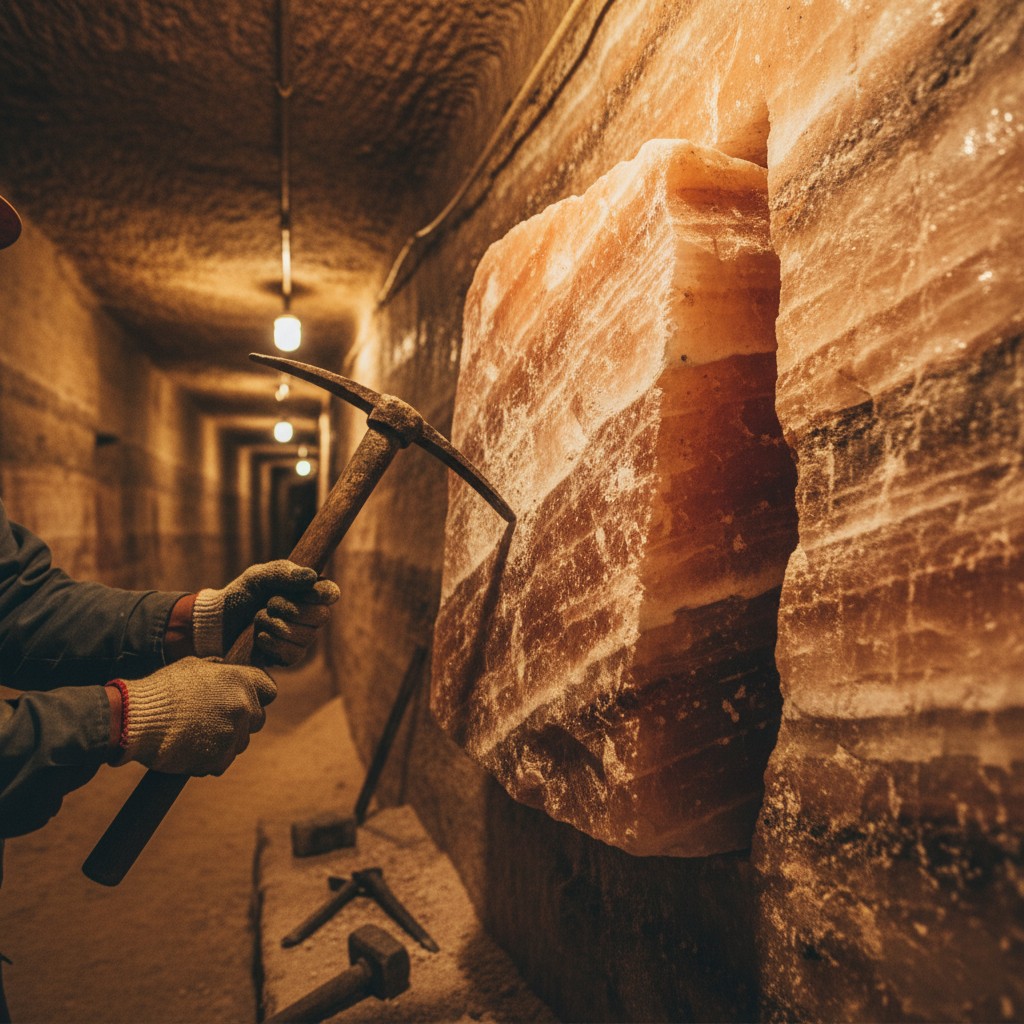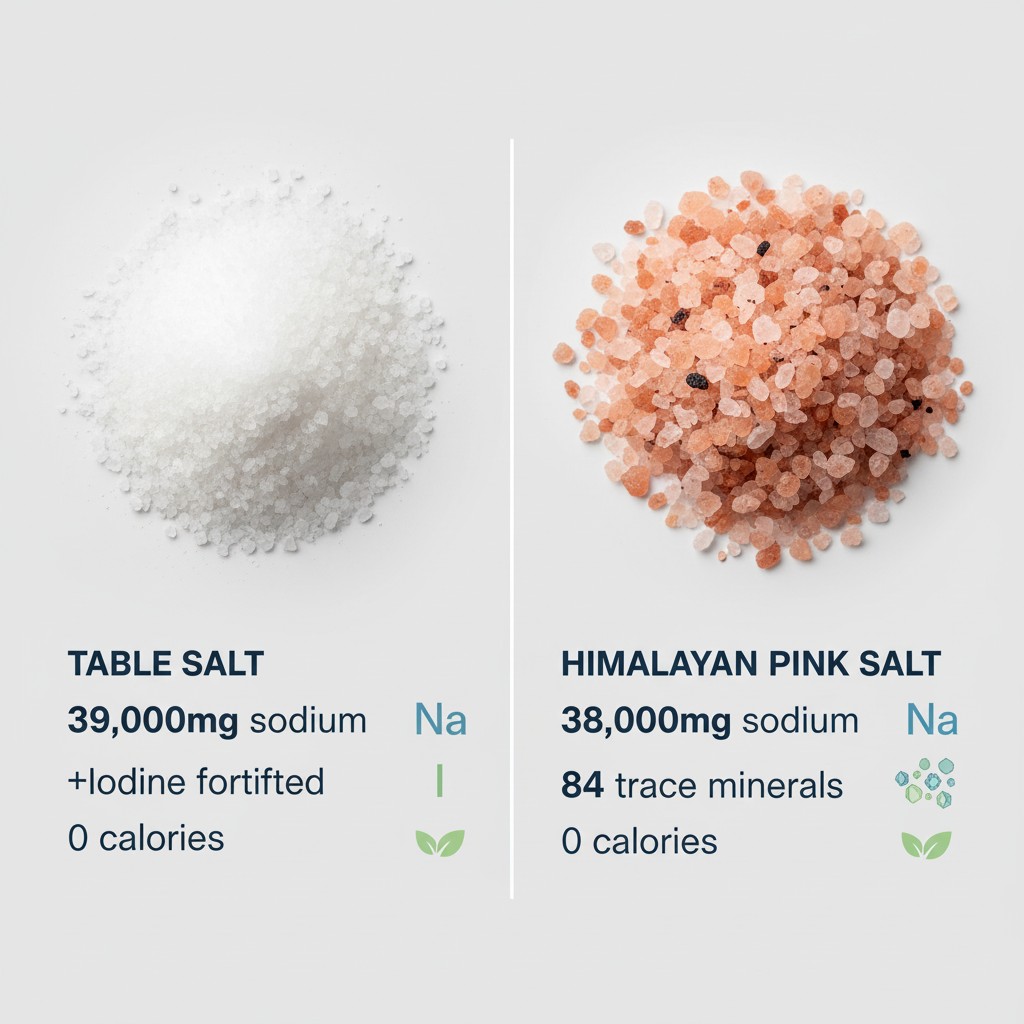Introduction
Salt is more than just a seasoning or taste enhancer – it is essential for life and flavors. From keeping the body hydrated and regulating nerve function to enhancing the taste of our food, salt plays a vital role in balancing our life and the flavors of the kitchen. Here we will discuss and differentiate Himalayan pink salt and table salt so you can choose wisely according to your needs.
What is Table Salt?
Table salt is the most common type of salt found in our kitchens and restaurant tables. It is made up of 97-99% sodium chloride (NaCl).
How it is made: Table salt is either mined from underground deposits or produced by evaporating seawater. After being mined or evaporated, the salt goes through extensive processing to eliminate impurities, then is fortified with iodine, a nutrient essential for our body and thyroid health. Anti-caking agents are added to prevent clumping, creating the fine texture we see in our kitchens.
Key Characteristics:
- Composition: ~99% sodium chloride (NaCl)
- Additives: Iodine (for thyroid support), anti-caking agents
- Color: White
- Texture: Fine-grained and uniform
- Flavor: Clean, sharp saltiness
- Uses: Everyday cooking, baking, seasoning, and food preservation
Despite its simplicity, table salt plays a critical role in nutrition and culinary precision.

What is Himalayan Pink Salt?
Himalayan pink salt is a type of rock salt that comes from the oldest salt mine in the world, located at the foothills of the Himalayas. It all started approximately 250 million years ago when an ancient prehistoric sea dried, leaving behind a thick layer of crystals, later sealed under the Himalayas.
How it is made: Himalayan pink salts are often hand-mined or extracted mechanically in the form of chunks, then washed, crushed, and sorted by size.
Key Characteristics:
- Composition: ~98% sodium chloride, with up to 84 trace minerals
- Color: Varies from light pink to deep rose due to mineral content
- Processing: Typically unrefined and free from additives
- Texture: Available in coarse crystals, fine grains, or slabs
- Uses: Cooking, finishing dishes, salt lamps, bath soaks, and even salt blocks for grilling
Himalayan pink salt is well known for its distinctive pink hue, which comes from various minerals present in it.

Nutritional Composition
Both table salt and Himalayan pink salt are mainly made of sodium chloride (NaCl), but they slightly differ in mineral content and processing.
Here is a detailed comparison of 100g of each salt:
Table Salt (Per 100g):
- Sodium: ~39,000 mg (99.8% sodium chloride)
- Calories: 0 kcal
- Protein, Fat, Carbs: 0 g
- Iodine: Added (amount varies by brand)
- Other minerals: Trace amounts of calcium (1.4 mg), potassium (0.5 mg), iron (0 mg)
Himalayan Pink Salt (Per 100g):
- Sodium: ~38,000–39,000 mg (approx. 98% sodium chloride)
- Calories: 0 kcal
- Protein, Fat, Carbs: 0 g
- Iodine: Not added
- Other minerals: Contains trace amounts of iron, calcium, magnesium, potassium, and up to 84 other minerals (in very small quantities)
The nutritional gap between the two salts is much smaller than most people think—the trace minerals in pink salt exist in very small amounts.

Health Considerations
Both salts are essential for life. Our body requires sodium to maintain fluid balance, nerve transmission, and muscle function. However, excessive consumption can cause high blood pressure and increase the risk of heart disease.
1. Sodium Intake: The Primary Concern
This is the most important health factor for all salts, regardless of color or type.
Sodium Content: Both Himalayan pink salt (95–98% NaCl) and table salt (97–99% NaCl) contain nearly 100% sodium chloride (NaCl). Therefore, excessive consumption of either salt can have negative health implications.
The Risk: Excessive sodium intake from any salt is directly linked with hypertension, high blood pressure, and heart disease.
Advice: Moderation is key. According to the World Health Organization (WHO) and American Heart Association (AHA), the recommended daily intake of sodium is around 2,300mg (about one tablespoon of table salt), and even less for people suffering from hypertension.
2. Iodine Content: A Public Health Difference
This is the most critical nutritional distinction between the two salts.
| Salt Type | Iodine Status | Health Implication |
|---|---|---|
| Iodized Table Salt | Added (Fortified) | Positive: A great source of iodine, an essential mineral for proper thyroid function and hormone production. This fortification is a major public health measure to prevent disorders like goiter and developmental issues. |
| Himalayan Pink Salt | Naturally Low/Absent | Potential Negative: Not fortified and naturally contains only negligible amounts of iodine. Solely relying on pink salt without consuming other iodine-rich foods (like dairy, eggs, fish, or seaweed) creates a risk of developing iodine deficiency. |
3. Trace Minerals and Purity
Himalayan Pink Salt (Less Refined):
- Benefit: Unprocessed or non-refined and contains 84 minerals like iron, potassium, magnesium, etc.
- Reality: Although minerals are present, they exist in very small amounts. There is no scientific proof of health benefits compared to table salt from these trace minerals—you would need to consume an unhealthy amount to get a beneficial dose.
- Minor Risk: Because it's unrefined, it may contain heavy metals, but in amounts too small to cause concern with typical consumption.
Table Salt (Refined):
- Potential Drawback: Processed/refined and contains anti-caking agents (like calcium silicate) to prevent clumping.
- Benefit: The refinement process eliminates impurities, including potential traces of heavy metals.
Culinary Uses and Preferences
Salt is not just a nutrient—it is one of the most powerful and important tools in cooking. The type of salt you use can significantly change the flavor, texture, and appearance of your dishes. Although they perform the same basic function of adding flavor, their texture, size, and purity can create different culinary experiences.

Cooking Uses of Table Salt:
- Everyday Cooking: Ideal for cooking and boiling as it dissolves quickly and evenly due to its smooth, uniform structure
- Precision Baking: Works perfectly in baking where precision matters, mixing evenly throughout—most baking recipes specify table salt
- Processed Foods: Many processed foods like snacks, canned goods, and ready-to-eat meals use table salt due to cost-effectiveness and availability
- Pickling and Preserving: Widely used in pickle preparation and brines
📌 Best for: Smooth-textured dishes, baking, and when exact salt concentration matters most.
Cooking Uses of Himalayan Pink Salt:
- Finishing Salt: Often used for sprinkling over dishes due to its beautiful pink hue and subtle mineral flavor
- Grilling and Serving: Large chunks of Himalayan pink salt blocks are used to grill foods or serve meats and seafood due to heat resistance and appealing structure
- Gourmet Appeal: Dishes like salads, steaks, and desserts use Himalayan pink salt for its luxurious appearance
Culinary Preferences and Trends
| Feature | Table Salt | Himalayan Pink Salt |
|---|---|---|
| Texture | Fine-grained, dissolves quickly | Coarse crystals, adds crunch |
| Flavor Profile | Clean, sharp saltiness | Mild, earthy undertone |
| Usage Style | Everyday cooking and baking | Gourmet finishing and presentation |
| Visual Appeal | Plain white | Distinctive pink hue |
| Health Perception | Functional and fortified (iodine) | Natural and unrefined (trace minerals) |
| Culinary Trend | Staple in traditional and industrial kitchens | Popular in wellness and artisanal cuisine |
| Cost & Accessibility | Inexpensive and widely available | Premium-priced and selectively marketed |
Cost and Availability
- Table salt is widely available in every household due to its affordability and utility
- Himalayan pink salt is positioned as a premium product through strategic marketing
- Himalayan pink salt is typically found in branded packaging or in the health-focused product category
Myths vs Facts
Table Salt Myths vs Facts
| Myth | Fact |
|---|---|
| "Table salt is unhealthy because it's processed" | Processing removes impurities and adds iodine, which is essential for thyroid health |
| "It causes high blood pressure more than other salts" | Every salt with high sodium content is harmful if consumed excessively |
| "Anti-caking agents are harmful" | These agents are approved for consumption and have negligible health impact in typical amounts |
| "Natural salts are always better" | "Natural" doesn't always mean healthier—iodine fortification is absent in natural salts, which is required to prevent deficiency |
Himalayan Pink Salt Myths vs Facts
| Myth | Fact |
|---|---|
| "Pink salt is healthier because it's natural" | It contains trace minerals, but the amounts are too small to significantly impact health |
| "It has less sodium, so it's safer" | The sodium content is nearly identical to table salt |
| "It detoxifies the body" | No scientific research proves this statement |
| "It can replace iodized salt" | It lacks iodine, which is very important—relying solely on pink salt is not recommended |
Conclusion
- Both salts are safe and useful, but neither is a "superfood"
- The main differences are in color, processing, and iodine content—not overall health value
- The best approach is to use any salt in moderation, as overconsumption of any salt will negatively affect health
- If you use Himalayan pink salt exclusively, ensure you get iodine from other dietary sources
- Table salt's iodine fortification provides a significant public health benefit that shouldn't be overlooked
- Choose based on your culinary needs and nutritional requirements, not on marketing claims